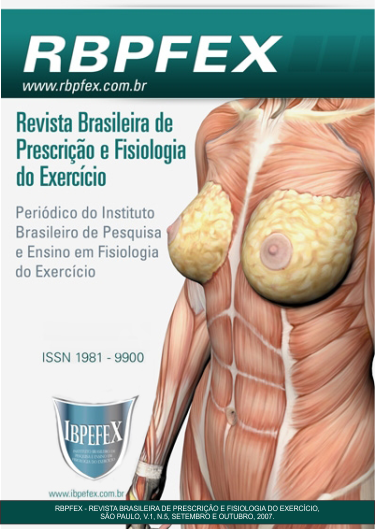Interference of the training of endurance into the strength increase and hypertrophy
Abstract
The Endurance training is characterized by its implementation in an aerobic zone, in other words, dependent on oxygen, is intended to promote the cardiovascular system and it is energetically sustained by the metabolism of fatty acids and carbohydrate. Along the execution occurs release of cortisol, that is a catabolic hormone released in situations of "stress". The action of cortisol in the body is one of the interference observed after several analyzed studies in this review, other factors were cited as depletion of substrates, mechanical failures and interference in fibers muscle adaptation. Several presented studies identify the interference in strength increase and hypertrophy of the skeletal muscle. Some relate to this interference the intensity, the week sections quantity, protocols and level of the practitioner conditioning. Other show results no comparatives evidence of interference, especially if performed on alternate days, different muscle groups, also cite the type of training of Endurance (race, cycle or rowing) as being essential to occur or not interference. Therefore we may conclude that most studies agree with the interference in both strength increase, as muscle hypertrophy that the training of Endurance bring out, and the metabolic and hormonal conditions are determinants for such interference.
References
- Aoki, M.S.; Pontes Jr, F.L.; Navarro, F.; Uchida, M.C.; Bacurau, R.F.P. Suplementação de carboidrato não reverte o efeito deletério do exercício de endurance sobre o subseqüente desempenho de força. Revista Brasileira de Medicina do Esporte 2003;9:282-7.
- Aoki, M.S,; Seelaender, M.C.L.; Suplementação lipídica para atividades de “endurance”. Revista Paulista de Educação Física 13(2): 230-38, jul./dez. 1999.
- Bucci, M.; Vinagre, E.C.; Campos, G.E.R.; Curi, R. Efeito do treinamento concomitante hipertrofia e endurance no músculo esquelético. Revista de ciência e movimento. São Paulo. v. 13. n. 1. 2005. p. 17-28.
- Fett, C.A.; Fett, W.C.R. Correlação de parâmetros antropométricos e hormonais ao desenvolvimento da hipertrofia e força muscular. Revista brasileira Ciências e Movimento. Brasília v. 11 n. 4 p. 27-32 out./dez. 2003.
- Fiamoncini, R.L. Avaliação do estresse oxidativo em jogadores juniores de futebol: comparação entre exercício aeróbio e anaeróbio. 2002. Dissertação (Mestrado em Engenharia de Produção) - Universidade Federal de Santa Catarina, Florianópolis, 2002.
- Fleck, S.J.E.; Kraemer, W.J. Fundamentos do treinamento de força muscular. 2ª edição. Porto Alegre: Editora Artmed, 1999.
- Gomes, R.V.; Aoki, M.S. Suplementação de creatina anula o efeito adverso do exercício de endurance sobre o subseqüente desempenho de força. Revista Brasileira de Medicina do Esporte, Brasil, v. 11, n. 2, p. 131-134, 2005.
- Gomes, R.V.; Matsudo, S.M.M.; Almeida, V.C.S.; Aoki, M.S. Suplementação de carboidrato associado ao exercício de força não afeta o desempenho do subseqüente teste de potência aeróbica. Revista Brasileira de Ciências do Movimento 2003;11:67-72.
- Meloni, V.H.M. Papel da hiperplasia na hipertrofia. Revista Brasileira de Cine. Des. Hum. 2005;7(1):59-63.
- Minamoto, V.B. Classificação e adaptações dos tipos de fibras musculares: uma revisão. Fisioterapia e Pesquisa, v. 12, n. 3, p. 50-55, 2005.
- Paulo, A.C.; Souza, E.O.; Laurentino, G.; Ugrinowitsch, Carlos.; Tricoli, Valmor. Efeito do treinamento concorrente no desenvolvimento da força motora e da resistência aeróbia. Revista Mackenzie de Educação Física e Esporte, São Paulo, v. 4, n. 4, p. 145-154, 2005.
- Powers, S.K. Fisiologia do Exercício: teoria e aplicação ao condicionamento e ao desempenho. Barueri. Manole. 2005 p. 82, 270.
- Robergs, R.A.; Roberts, S.O. Princípios Fundamentais de Fisiologia do Exercício: para Aptidão, Desempenho e Saúde. São Paulo. Phorte. 2002.
- Simões, H.G.; Marcon, Oliveira, F.; Campbell, C.S.G.; Baldissera, V.; Costa Rosa, L.F.B.P. Resposta da razão testosterona/cortisol durante o treinamento de corredores velocistas e fundistas. Revista brasileira Educação Física e Esporte, São Paulo, v. 18, n. 1, p. 31-46, jan./mar. 2004.
- Santos, F.V. Relacionamento entre alguns tipos de força e a velocidade de deslocamento em jogadores de basquetebol juvenil. Curitiba, PR. 2006. (Dissertação de Mestrado) departamento de educação Física. UFPR.
- Terjung, R.L. Adaptações musculares ao treinamento aeróbio. Disponível em: http://www.gssi.com.br/scripts/publicacoes/artigos/artigo.asp?idartigo=19 Acesso em 23 de outubro de 2007 (publicado em 1997).
- Uchida, M.C.; Aoki, M,S.; Navarro, F.; Tessutti, V.D.; Bacurau, R.F.P.; Efeito de diferentes protocolos de treinamento de força sobre parâmetros morfofuncionais, hormonais e imunológicos. Rev Bras Med Esporte ,Brasil. v. 12, n. 1 – Jan/Fev, 2006.
- Uchida, M.C.; Bacurau, R.F.P.; Navarro, F.; Pontes Junior, F.L.; Tessuti, V. D.; Moreau, R.L.; Costa-Rosa, L.F.P.B.; Aoki, M.S. Alteração da relação testosterona: cortisol induzida pelo treinamento de força em mulheres. Revista Brasileira de Medicina do Esporte, Brasil, v. 10, n. 3, p. 165-168, 2004.
- Verkhoshanski, Y.V. Força: treinamento da potência muscular. ; tradução e adaptação: Antônio Carlos Gomes e Ney Pereira de Araújo Filho. 1. ed. Londrina. Centro de Informações Desportivas, 1996. p. 43.
- Vieira, A.P.; Prado, F.G.A. Ordem dos exercícios no treinamento de força, como fator modificador da intensidade nos níveis iniciante, intermediário e avançado. Periódico. Dissertação. Campo Grande, MS, 2005(Trabalho de conclusão de curso) curso de Educação Física, UCDB. p. 18.
- Weineck, J. Treinamento ideal. 9º ed., Ed. Manole. São Paulo. SP. 1999. p. 224-243.
Authors who publish in this journal agree to the following terms:
- Authors retain the copyright and grant the journal the right of first publication, with work simultaneously licensed under the Creative Commons Attribution License BY-NC which allows the sharing of the work with acknowledgment of the authorship of the work and initial publication in this journal.
- Authors are authorized to enter into additional contracts separately for non-exclusive distribution of the version of the work published in this journal (eg, publishing in institutional repository or book chapter), with acknowledgment of authorship and initial publication in this journal.
- Authors are allowed and encouraged to post and distribute their work online (eg, in institutional repositories or on their personal page) at any point before or during the editorial process, as this can bring about productive change as well as increase impact and impact. citation of published work (See The Effect of Free Access).






